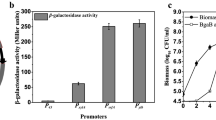Abstract
We evaluated the effect of several genetic factors reported as having a role in the induction of the expression of significant levels of recombinant protein in Bacillus subtilis. We utilized the β-galactosidase reporter protein from Escherichia coli as our model for measuring the overproduction of heterologous proteins in B. subtilis. The lacZ gene was expressed in B. subtilis using the regulatory region of the subtilisin gene aprE. In this study, we considered factors known to modulate the transcription and translation initiation rates and genetic and mRNA stability. We also consider the effects of different genetic backgrounds, such as degU32 and hpr2, that until now have been studied independently. By changing the native −35 promoter box to the consensus TTGACA sequence of the aprE promoter, a significant 100-fold increase in the β-galactosidase activity was obtained. On the other hand, changes such as the GTG to ATG start codon, the construction of a consensus AAGGAGG ribosome binding site, and the addition of the cryIIIA transcription terminator at the 3′ end of the lacZ gene, produced only marginal effects on the final β-galactosidase activity.
Similar content being viewed by others
Author information
Authors and Affiliations
Additional information
Received: 27 January 2000 / Received revision: 25 May 2000 / Accepted: 9 June 2000
Rights and permissions
About this article
Cite this article
Jan, J., Valle, F., Bolivar, F. et al. Construction of protein overproducer strains in Bacillus subtilis by an integrative approach. Appl Microbiol Biotechnol 55, 69–75 (2001). https://doi.org/10.1007/s002530000448
Issue Date:
DOI: https://doi.org/10.1007/s002530000448




